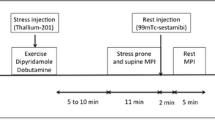Abstract
Objective: To study the feasibility of continuous intravenous SonoVue contrast echocardiography for qualitative assessment of reversible myocardial perfusion in dipyridamole stress tests. Methods: Eleven patients (10 male and 1 female, mean age 66 years) with a history of chest pain and a clinical indication for stress sestamibi–single photon emission computed tomography (SPECT) underwent concurrent SonoVue 99mTc myocardial contrast echocardiography (MCE). Results: Of the total 176 segments obtained, 53 (30%) were regarded as indeterminate, 39 (22%) as discordant, and 84 (48%) as concordant between MCE and SPECT imaging. Two patients had abnormal SPECT results. The overall feasibility and specificity of MCE were 70 and 74%, respectively. The concordant (p = 0.59) and discordant (p = 0.55) segments were comparable with either MCE technique. However, continuous low-mechanical-index imaging produced fewer indeterminate segments (17 segments, 32%) than intermittent harmonic B-mode imaging (36 segments, 68%) (p = 0.04). Significantly more indeterminate segments were found in the left anterior descending artery territory. However, the overall concordance was similar (p = 0.5) in all three coronary artery territories. The concordance and discordance rates at different left ventricular levels (i.e., basal, mid, and apical) were similar (p = 0.50 and 0.08, respectively). Conclusion: Continuous-infusion SonoVue contrast echocardiography is feasible, with high specificity, for detecting myocardial perfusion defects as assessed by dipyridamole SPECT.
Similar content being viewed by others
References
Heinle SK, Noblin SL, Goree-Best P, et al. Assessment of myocardial perfusion by harmonic power Doppler imaging at rest and during adenosine stress: comparison with 99mTcsestamibi SPECT imaging. Circulation 2000; 102: 55–60.
Porter TR, Xie F, Silver M, Kricsfeld D, Oleary E. Realtime perfusion imaging with low mechanical index pulse inversion Doppler imaging. J Am Coll Cardiol 2001; 37: 748–753.
Broillet A, Puginier J, Ventrone R, Schneider M. Assessment of myocardial perfusion by intermittent harmonic power Doppler using SonoVue, a new ultrasound contrast agent. Invest Radiol 1998; 33: 209–215.
Investigator's Brochure, SonoVue (BR1) contrast medium for ultrasound (abstract). Bracco S.p.A. December 18, 2000. Retrieved February 5, 2002; http://www.emea.eu.int.
Senior R, Kaul S, Soman P, Lahiri A. Power Doppler harmonic imaging: a feasibility study of a new technique for the assessment of myocardial perfusion. Am Heart J 2000; 139: 245–251.
Christian TF, Miller TD, Bailey KR, Gibbons RJ. Noninvasive indentification of severe coronary artery disease using exercise tomographic thallium-201 imaging. Am J Cardiol 1992; 70: 14–20.
Executive Summary of the Third Report of the National Cholesterol Education Program (NCEP) Expert Panel on Detection, Evaluation, and Treatment of High Blood Cholesterol in Adults (Adult Treatment Panel III). JAMA 2001; 285: 2486–2497.
Wei K, Jayaweera AR, Firoozan S, Linka A, Skyba DM, Kaul S. Quantification of myocardial blood flow with ultrasound-induced destruction of microbubbles administered as a constant venous infusion. Circulation 1998; 97: 473–483.
Bach DS, Muller DW, Cheirif J, Armstrong WF. Regional heterogeneity on myocardial contrast echocardiography without severe obstructive coronary artery disease. Am J Cardiol 1995; 75: 982–986.
Holland MR, Wilkenshoff UM, Finch-Johnston AE, Handley SM, Perez JE, Miller JG. Effects of myocardial fiber orientation in echocardiography: quantitative measurements and computer simulation of the regional dependence of backscattered ultrasound in the parasternal shortaxis view. J Am Soc Echocardiogr 1998; 11: 929–937.
Shimoni S, Zoghbi WA, Xie F, et al. Real-time assessment of myocardial perfusion and wall motion during bicycle and treadmill exercise echocardiography: comparison with single photon emission computed tomography. J Am Coll Cardiol 2001; 37: 741–747.
Porter TR, Li S, Kricsfeld D, Armbruster RW. Detection of myocardial perfusion in multiple echocardiographic windows with one intravenous injection of microbubbles using transient response second harmonic imaging. J Am Coll Cardiol 1997; 29: 791–799.
Kaul S, Senior R, Dittrich H, Raval U, Khattar R, Lahiri A. Detection of coronary artery disease with myocardial contrast echocardiography: comparison with 99mTc-sestamibi single-photon emission computed tomography. Circulation 1997; 96: 785–792.
Beller GA. Clinical Nuclear Cardiology. Philadelphia: WB Saunders Company, 1995; 37–81.
Iskandrian AS, Verani MS. Nuclear Cardiac Imaging: Principles and Applications. 2nd ed. Philadelphia: FA Davis Company, 1996; 29–45.
Parodi O, Schelbert HR, Schwaiger M, Hansen H, Selin C, Hoffman EJ. Cardiac emission computed tomography: underestimation of regional tracer concentrations due to wall motion abnormalities. J Comput Assist Tomogr 1984; 8: 1083–1092.
Asanuma T, Belohlavek M, Bae RY, Greenleaf JF, Seward JB. Radiofrequency spectral analysis of attenuated ultrasound signals in experiments with echo contrast microbubbles. J Am Soc Echocardiogr 2001; 14: 789–797.
Marwick TH, Brunken R, Meland N, et al. Accuracy and feasibility of contrast echocardiography for detection of perfusion defects in routine practice: comparison with wall motion and technetium-99m sestamibi single-photon emission computed tomography. The Nycomed NC100100 Investigators. J Am Coll Cardiol 1998; 32: 1260–1269.
Author information
Authors and Affiliations
Rights and permissions
About this article
Cite this article
Yip, G.W., Chandrasekaran, K., Miller, T.D. et al. Feasibility of continuous venous infusion of SonoVue for qualitative assessment of reversible coronary perfusion defects in stress myocardial contrast echocardiography. Int J Cardiovasc Imaging 19, 473–481 (2003). https://doi.org/10.1023/B:CAIM.0000004263.46151.9d
Issue Date:
DOI: https://doi.org/10.1023/B:CAIM.0000004263.46151.9d




